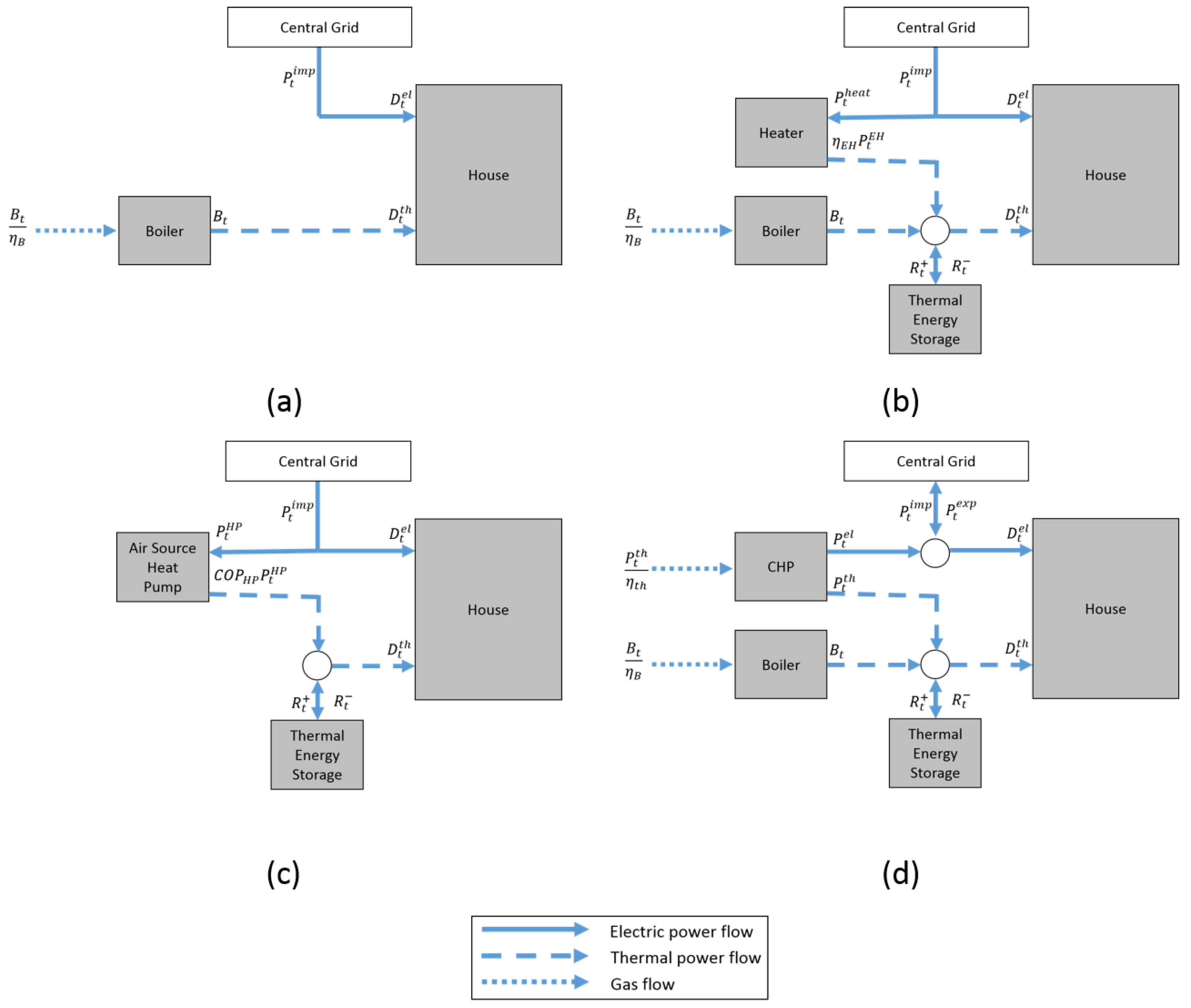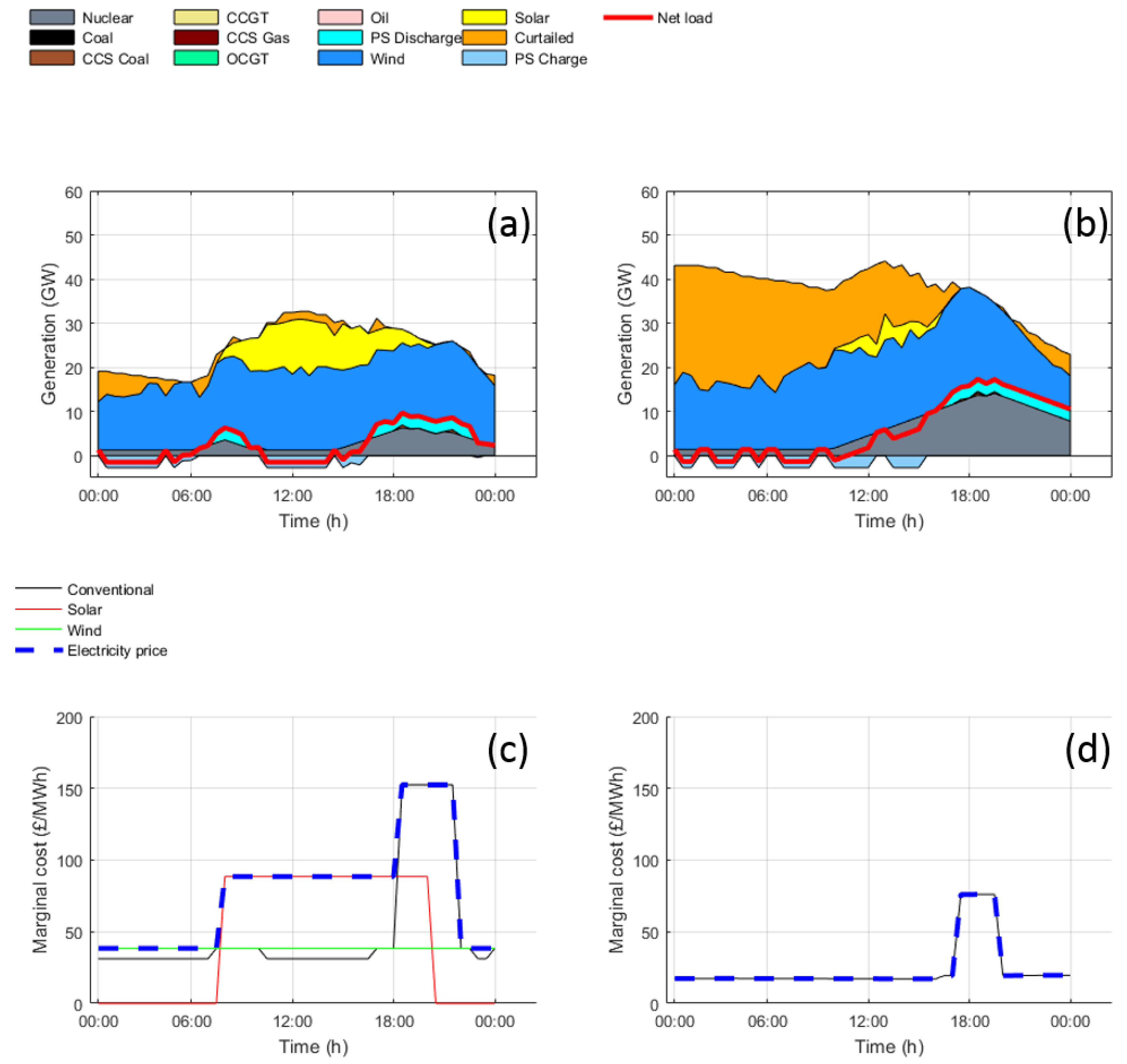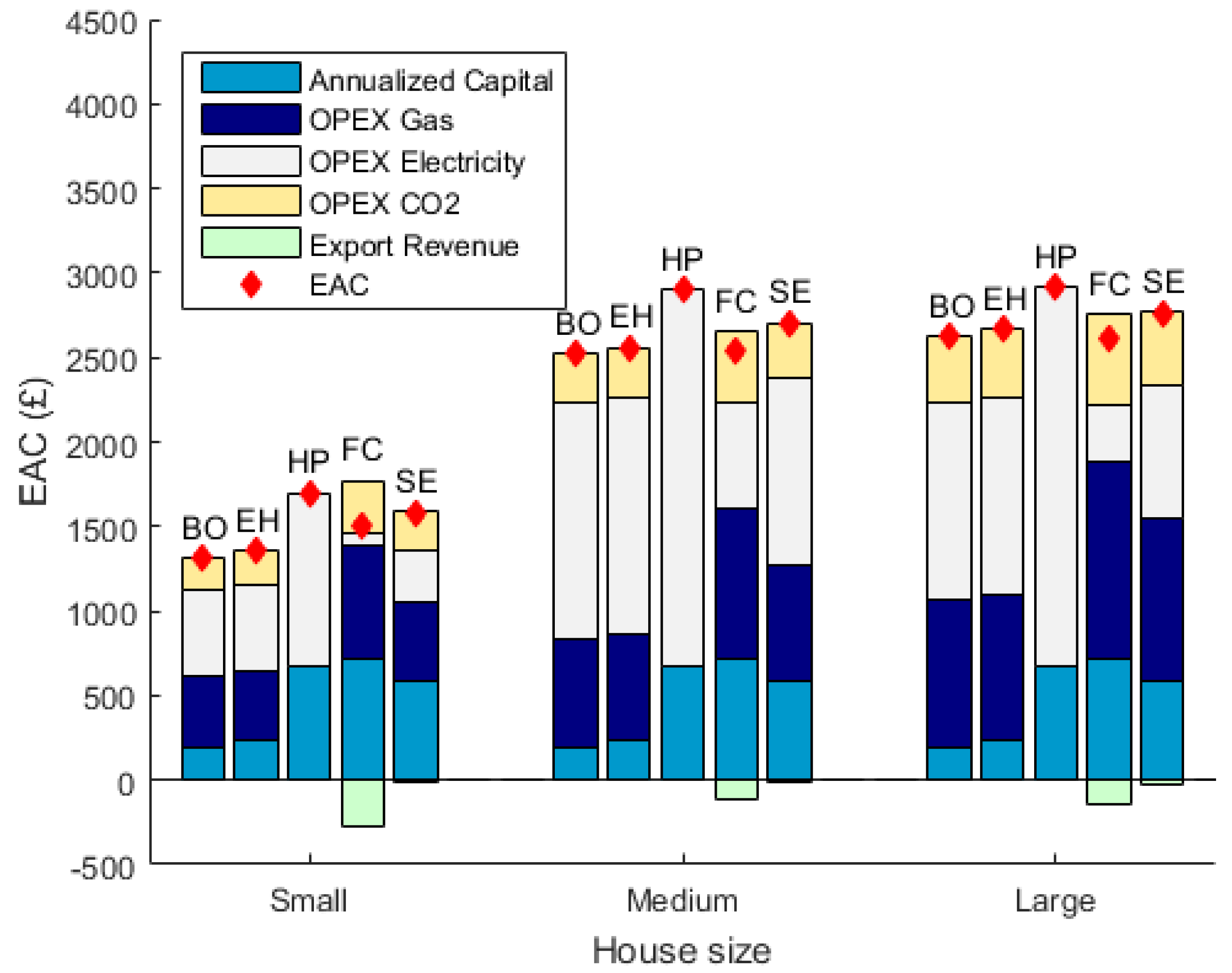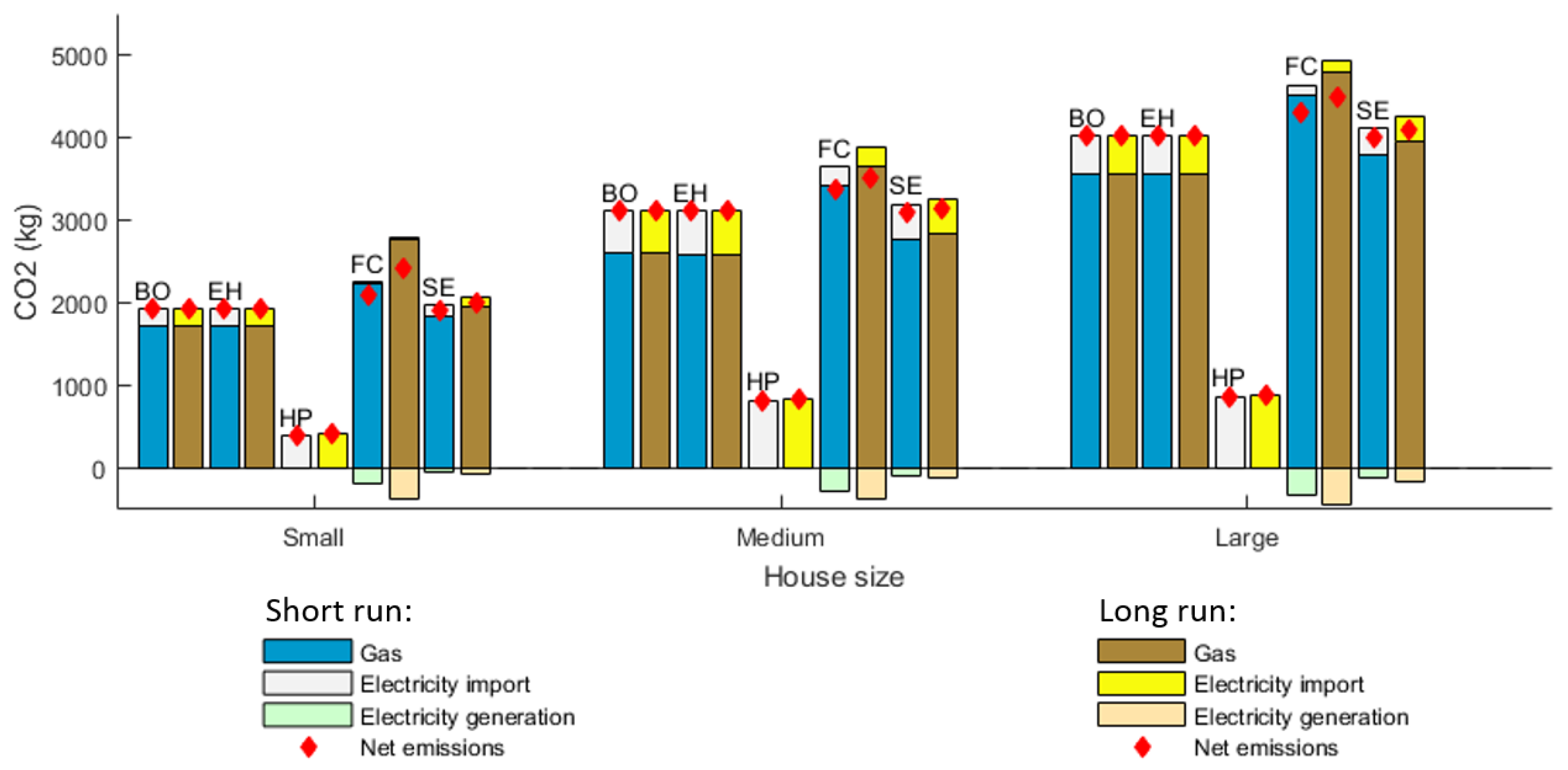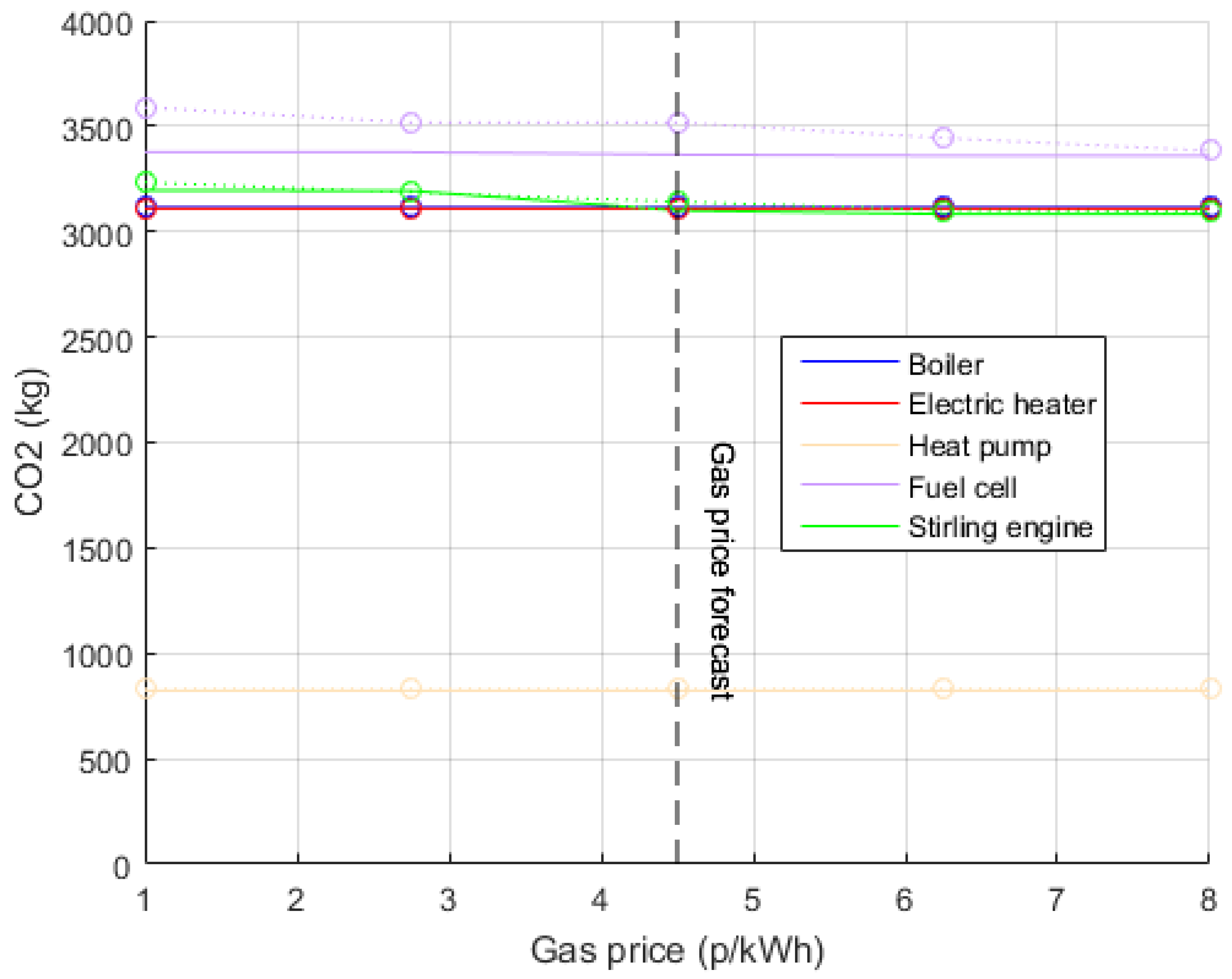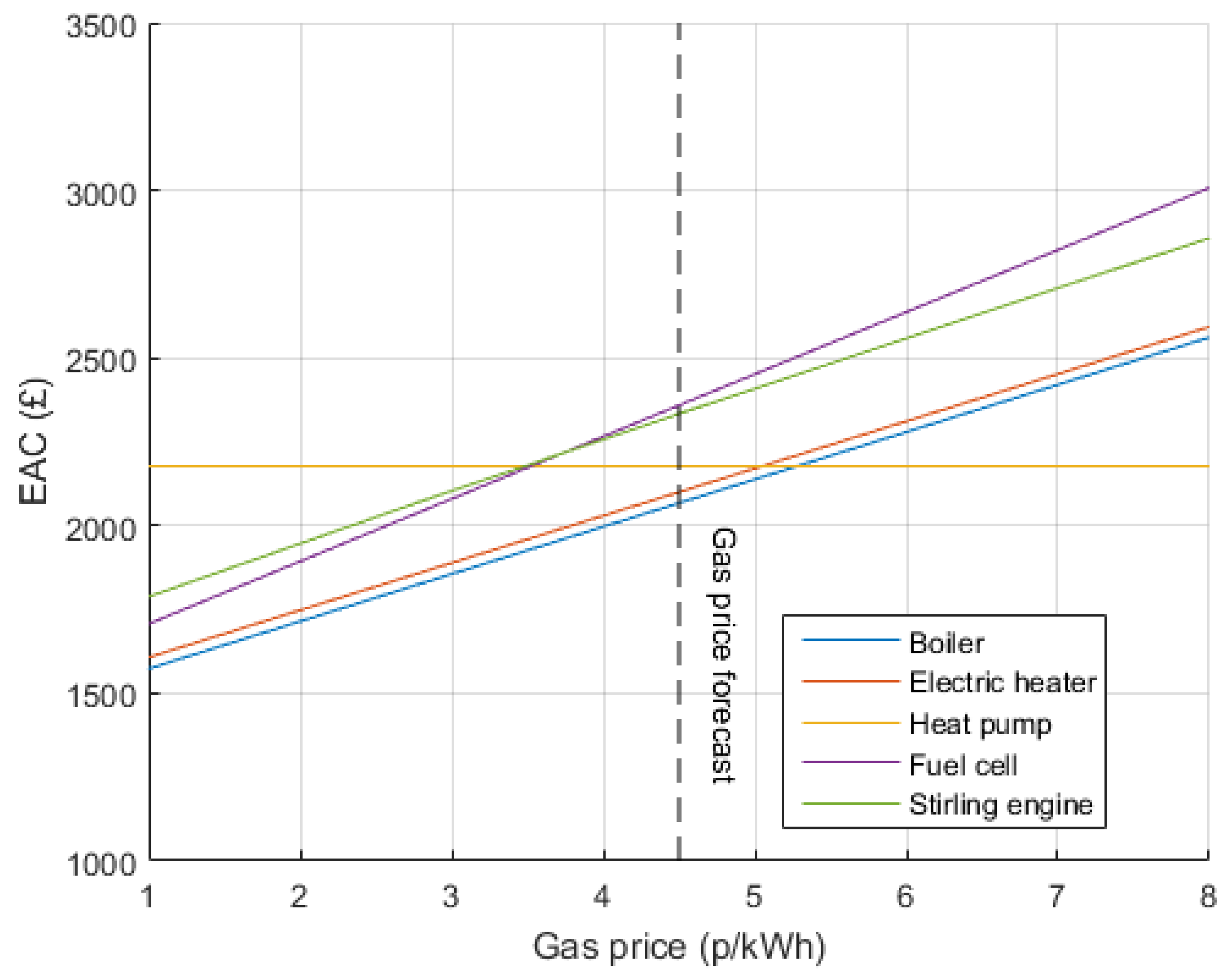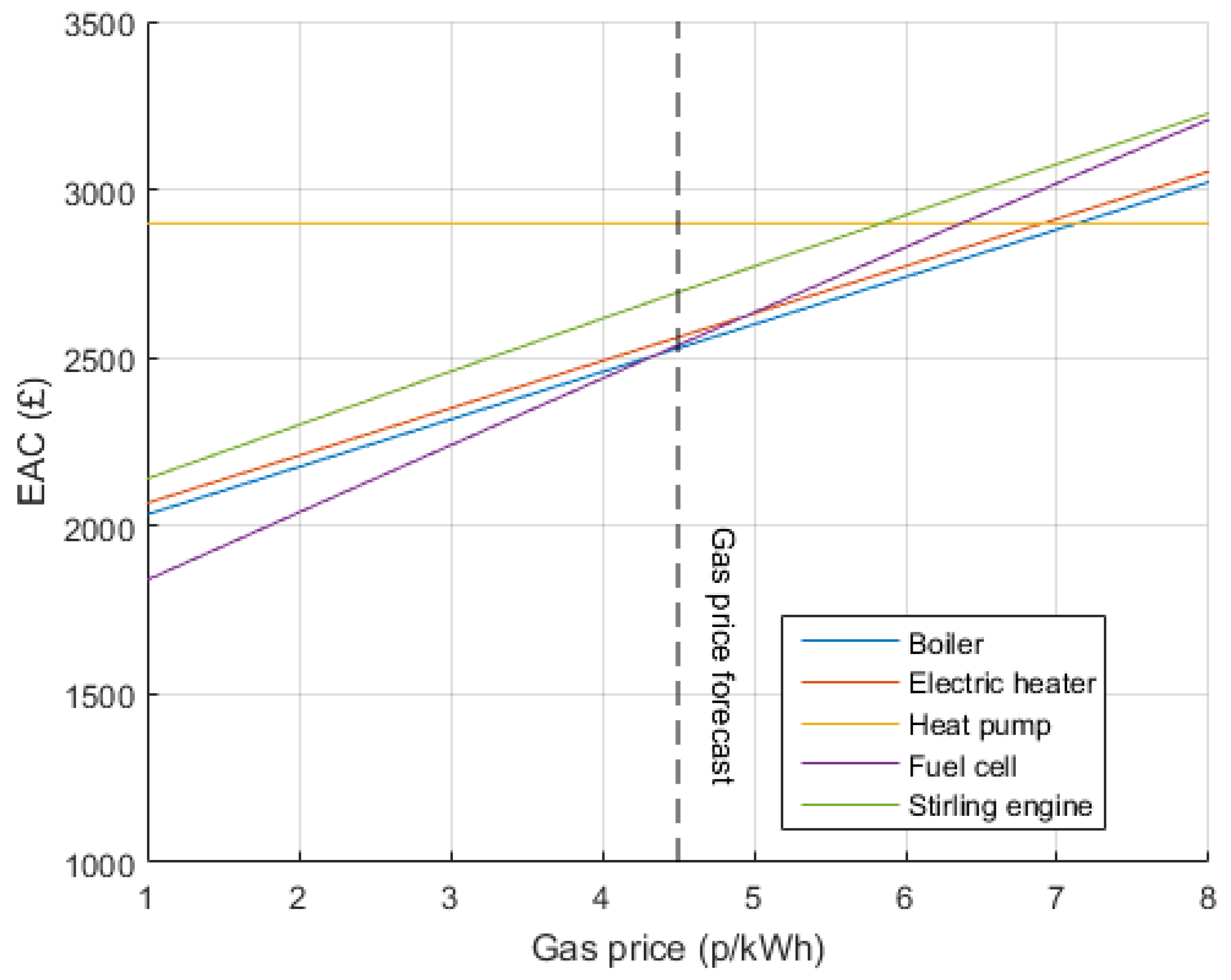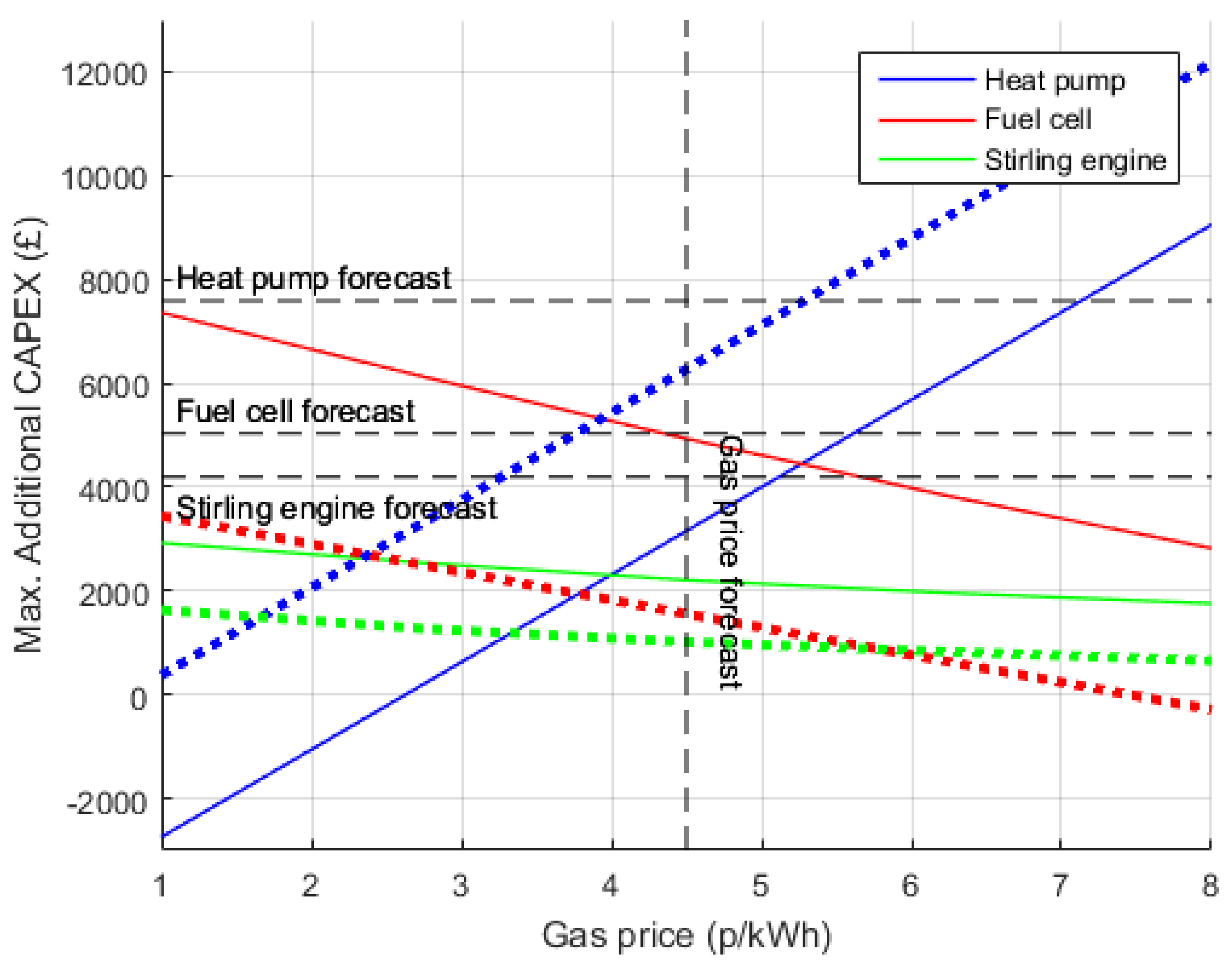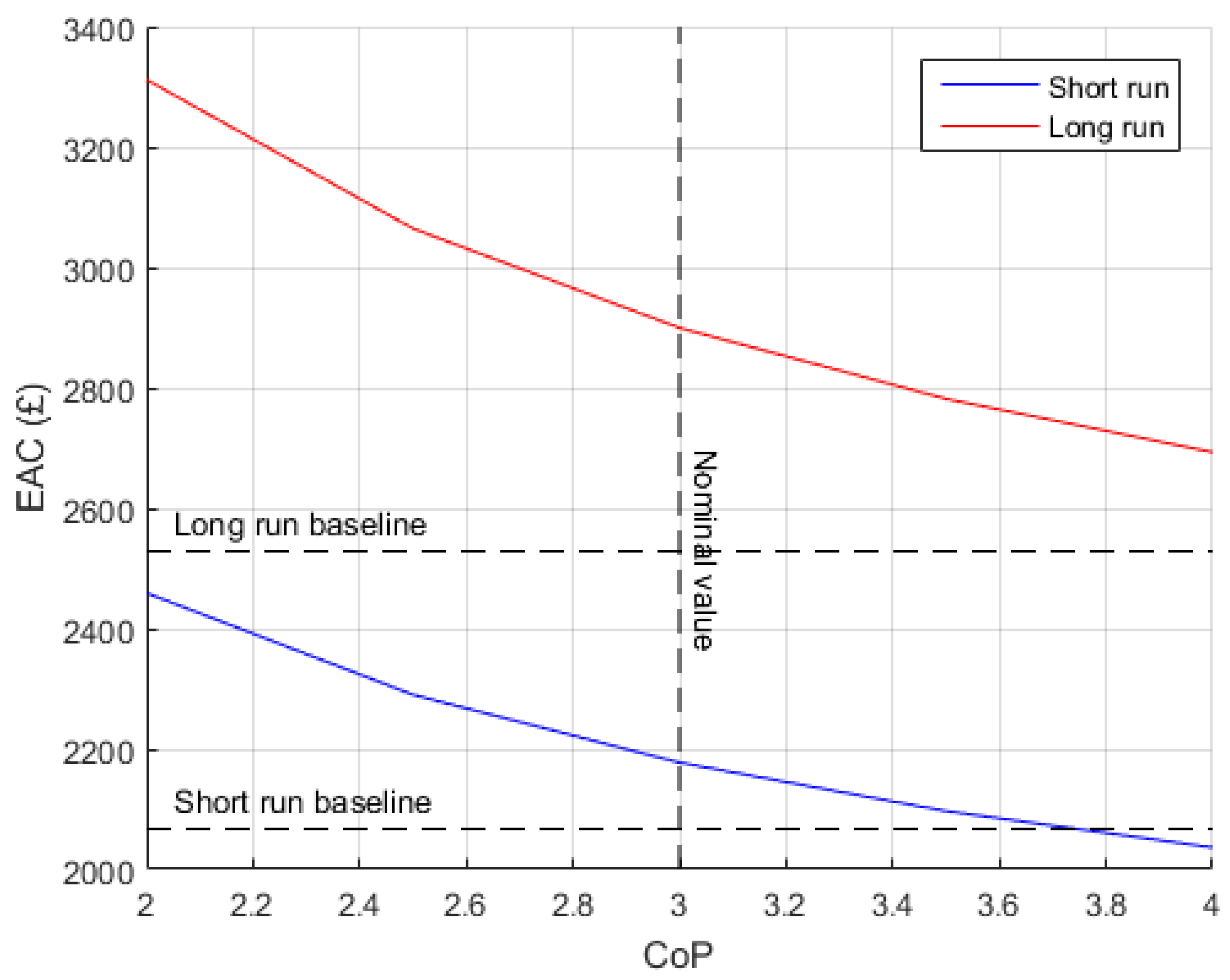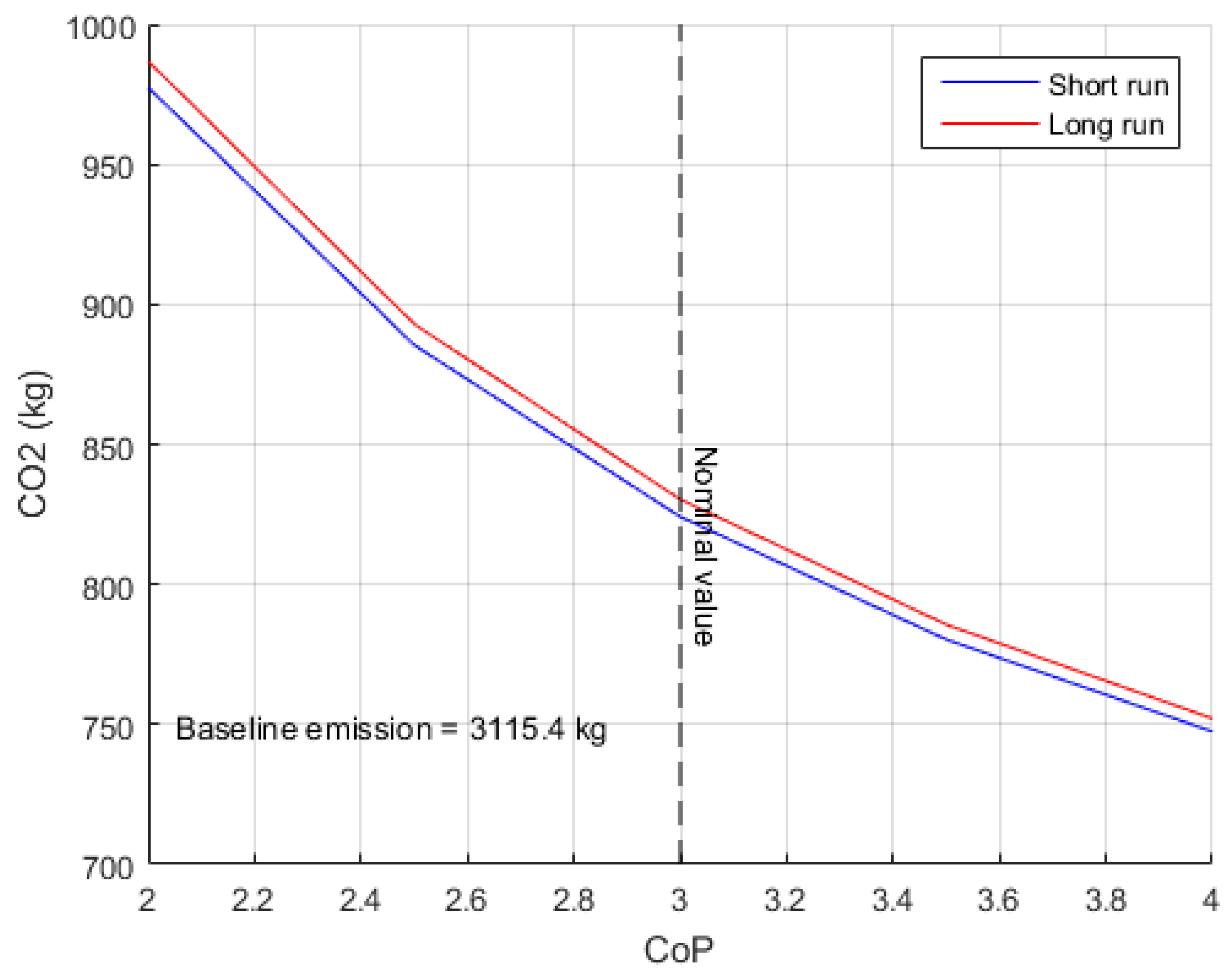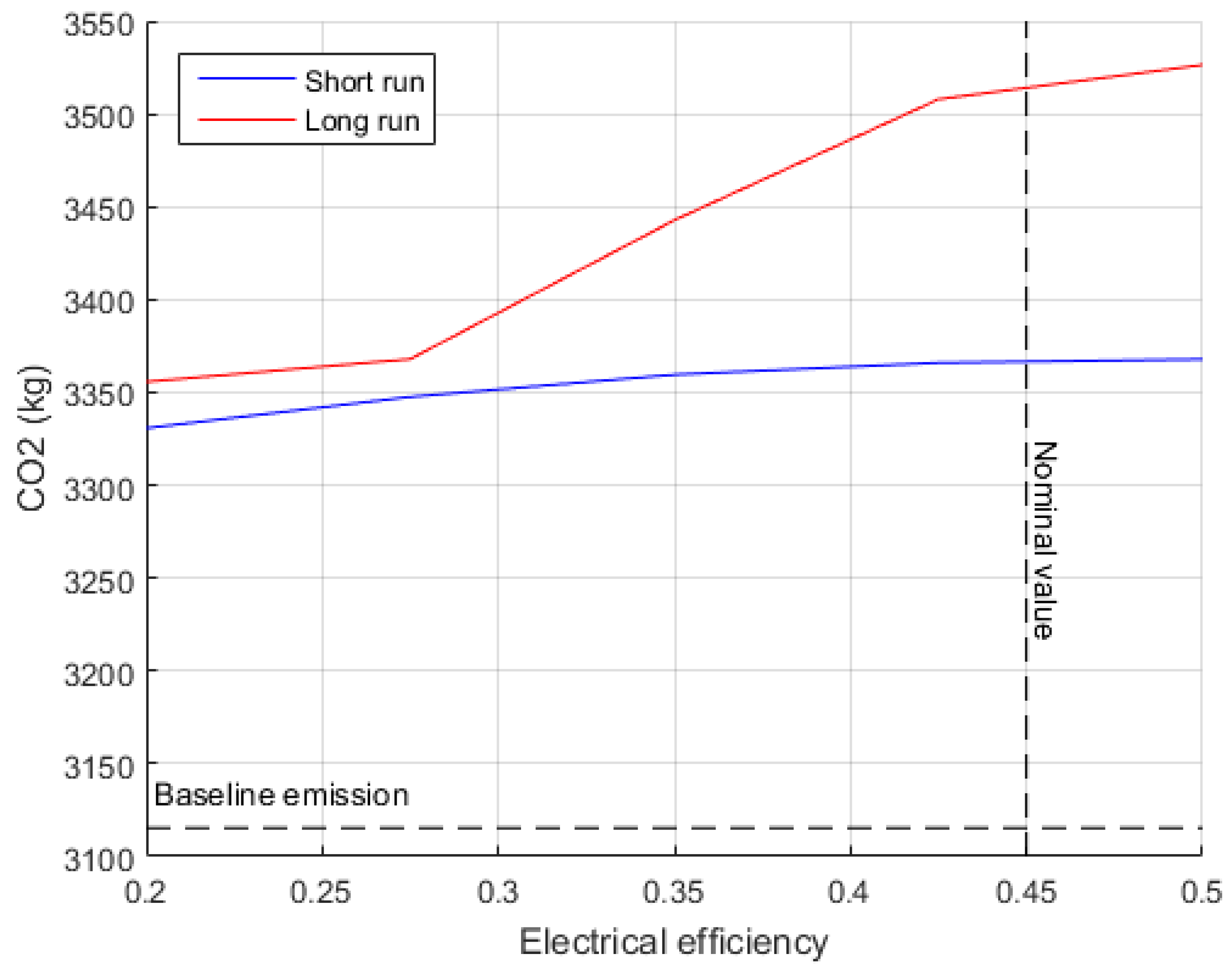1. Introduction
The decarbonisation of heat provision is one of the main challenges of broader climate change mitigation [
1]. Heat is a significant end-use, for example in the UK space and water heating makes up 23% of final energy consumption and 55% of non-transport energy consumption [
2]. It is also typically relatively carbon intensive, relying on fossil fuels such as natural gas [
1], and is underpinned by long-established and low-cost incumbent technology such as boilers serving demand [
3]. While alternative technology and fuel options certainly exist for heating, they are generally either significantly costlier [
4], or require infrastructure build in the form of district level heat networks as installing components that cater to individual houses is not economically viable [
5].
This range of factors makes heat difficult to decarbonise, and therefore an important area of energy research. This is reflected in the literature, with a range of studies exploring the engineering challenges and performance of different heating technologies [
6,
7,
8,
9,
10,
11,
12,
13,
14,
15,
16,
17,
18]. The vast majority of the studies that consider techno-economics do so in the context of the present-day energy system. However, the energy system within which heating technologies operate is expected to change significantly in the coming decades [
19,
20]. In particular, decarbonisation of electricity is seen as a cornerstone of any system-wide climate change mitigation strategy [
21]. Therefore, it is important and timely to consider heating technologies in the context of this changing system.
One of the developments in a low carbon future that is of importance is the evolution of electricity prices. If the market follows the status quo and is driven by short run marginal cost, it is seen to provide very weak economic incentives for investment in the electricity system. Therefore, it cannot represent a sustainable price to consumers. It is clear that new electricity market signals will be necessary in the future. Generators will need to mitigate the risk associated with low utilization and low market prices in order to remain viable. One way that risk is currently handled by low carbon generators is through the use of instruments such as Contract for Difference. This provides the low carbon generator with a stable revenue stream in the face of uncertainty. Since such solutions are critical to ensure smooth operation of the electricity grid, this study introduces the use of a fixed power purchase agreement. Generators receive a constant charge for all power they inject into the grid. If this charge is priced by accounting for upfront costs and capacity factor, the revenue generated will able to recover the money invested. This presents a simple and arguably a reasonable way forward for all generators participating in the market. More complex instruments are possible, the design of which is beyond the scope of this article.
This article considers the techno-economics of small-scale residential heating technologies within a changing energy system. It develops a technology-rich model of a range of small-scale heating systems, and considers their economic performance in scenarios of broader energy system change drawn from a new dispatch model of the electricity system. By bringing these models together new insights can be drawn into the primary factors that impact upon the success of approaches to residential heat decarbonisation.
The primary novel contributions of this study are highlighted as follows. The key contribution is the analysis of individual residential heating systems in the context of electricity system decarbonisation, through the combination of an electricity dispatch model with an individual residential heating system model. This article incorporates Equivalent Annual Cost (EAC) as the performance index which drives technology selection in contrast to existing works which compare primary energy consumption and emissions. This is done since economic viability is seen to be the most important factor from the consumer’s perspective. This analysis also required characterisation of an electricity price regime that is based on long run marginal electricity costs. Hence this work has developed an electricity price regime that incorporates capital costs and annual utilization, analogous to the cost of power purchase agreement or similar market instruments suitable for low carbon generators.
The article is structured as follows: the next section presents the background context to this problem, reviewing the challenge and studies to date. This is followed by the methodology applied herein to characterise small scale heating and the possible energy systems it could operate within. The results are then presented and discussed, leading to conclusions.
2. Background
Heat decarbonisation measures can be broadly classified into four groups: Behavioural and efficiency measures, electric heating, low carbon gases and district heating networks. Behavioural and efficiency measures can reduce demand through the use of insulation [
22], orientation [
23], heating controls [
24] high efficiency boilers [
25] and changes in behaviour or attitudes towards heating [
26]. Another approach to efficiency is the use of micro combined heat and power (micro-CHP) to produce both electricity and heat onsite [
27]. Low carbon electricity is also a key contender, as the electricity grid begins to incorporate higher shares of wind, solar and other low carbon sources. Heat pumps present an opportunity to consume this electricity and reduce carbon emissions in the process [
28]. Bioenergy can reduce GHG emissions by processing renewable materials such as wastewater into useful fuels, most commonly through anaerobic digestion [
29]. Synthetic natural gas and hydrogen are other possible alternatives to natural gas [
30,
31], and can be applied in conventional technologies such as boilers or alternatives such as fuel cell based micro-CHP. Furthermore, larger-scale heat production coupled with a heat distribution network, also offers opportunities to decarbonise heating at various levels ranging from community to city wide projects [
32].
Many studies consider specific options for the decarbonisation of heat. Combined heat and power, heat networks and fuel substitution are seen to be options that can potentially decrease carbon emissions in industry [
33]. A wide range of other options are also present in the literature: Energy efficiency is likely to be part of the future regardless of the end-use technology and supply source chosen, and hence clear goals must be set to encourage their adoption [
34]. Heat pumps are another option. Although entailing high capital cost, heat pumps are seen produce considerable emission savings [
17], though this clearly depends on prevailing conditions such as the carbon intensity of the national electricity grid [
35]. District heating is also seen to show great promise to reduce emissions but is highly dependent on policy or regulatory support in order to support coordinated roll out and uptake [
36]. Direct use of hydrogen is an option with the added benefit of possibly using existing gas network infrastructure, but would require network adaptation and consumers to switch appliances [
37]. Although many options exist, most are there exists no comparison between technologies with the status quo in terms of investment and operating cost in a future scenario. Thus, the challenge of decarbonising heat is far from solved. In this study we consider options that an individual consumer can choose to install without requiring changes in heat network infrastructure or in the supply side.
It is important to recognise that the decarbonisation of heat will take place within broader energy system decarbonisation, a point that has not been comprehensively studied. The authors have shown in [
38] that decarbonisation of the power sector leads to changes in electricity prices. Therefore, it is important to consider the economic performance of heating technologies within this changing energy landscape. Typically, such cross-system interactions are investigated via use of whole energy system models. For example, the intersection between broader energy systems and the supply of heat has been studied in [
39,
40,
41,
42]. Recent applications of such models focus on identification of optimal pathways of energy system change [
19]. These tools typically operate at the national, regional or global level, and as such are necessarily coarsely temporally and spatially-resolved [
43]. Though they are suitable for macro-level analysis, the characteristics of individual entities are lost during aggregation, and more detailed highly-resolved and investor-centric models are needed to explore and test the potential solutions that they present.
While many articles in the literature consider a single heating technology, relatively few are devoted to the comparison of heating options. The references summarised in
Table 1 are closest to the scope of this article. The main distinctions between them are related to whether a current or future energy system is considered, the heating system control strategy used, and the types of models that define operation and system description. References that use a representation of individual consumers are limited to the present-day energy system [
15,
16], with the exception of [
17,
18] where the discussion of the future is limited to the change in carbon intensity of electricity generation. Aggregated representations [
44,
45] do not provide information about the performance of an individual household. Therefore, such models cannot showcase the impact of technology adoption on the individual consumer.
It is worth noting that the studies that deal with individual consumers in
Table 1 focus on primary energy consumption and carbon emissions as an indicator of performance. Consumer adoption of a new technology is not decided by these factors but by whether the technology is economically viable or not. Hence, the methodology described in this work adds a critical dimension to the assessment of small scale heating systems of the future.
5. Conclusions
In this paper a novel modelling approach to analysing the impact of power system decarbonisation on the techno-economics of low carbon heating systems has been presented. Since high penetration of low carbon sources in the electricity system is seen to weaken the economic case for investment in generation capacity, an electricity regime based on long run costs instead of short run costs is introduced. In addition to this an optimization model that determines operating strategies to handle time varying electricity prices and energy balance of thermal energy storage is also discussed. The different sections come together to evaluate technology viability in a future scenario with high penetration of solar, wind and nuclear sources.
The different heating technologies considered are quite similar in terms of annualised cost effectiveness even with optimal operating strategies. Success is likely to be driven by evolution of market conditions, the carbon intensity of the central grid and design improvements in technologies, all of which have been covered in the sensitivity studies. Fuel cells show the most potential under the long run electricity price regime and heat pumps show the most potential under the short run electricity price regime. Technology adoption may also be influenced by factors not central to economic or environmental performance such as perceived comfort and relative inconvenience of installation. Such factors are beyond the scope of this article and are flagged as directions for future research.
The energy requirement of small and medium houses are not sufficient to warrant the installation of new technologies. The savings in operational cost begins to add value for the consumer only when the technologies are installed in dwellings with high values of annual heat demand.
If carbon abatement is the top priority, heat pumps outperform all other options considered in this paper. However, their economic case is weakened by high capital costs, or by the higher electricity prices observed in the long run electricity pricing regime. Therefore, achieving deep reductions in residential space heating emissions will likely require stronger policy instruments in the medium term; the non-traded carbon price forecast at the time of writing is not sufficient.
Overall it is evident from the results that the best performing heating technology in the future is closely tied to the electricity price regime. The means the electricity market arrangements that determine how price is formed for the consumer will have a significant impact on heating techno-economics. The model described here is a useful tool to evaluate heating systems of the future from the consumer perspective.

